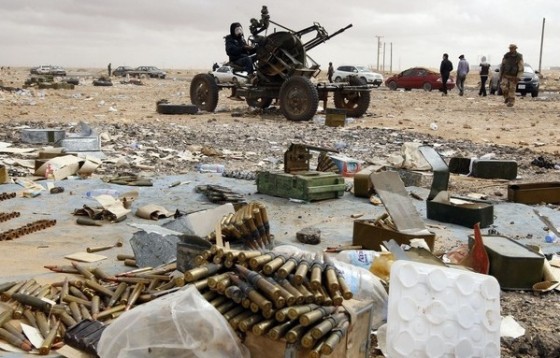 Looking for scrap metal, unexploded ordinances a major danger to local Libyans
Looking for scrap metal, unexploded ordinances a major danger to local Libyans
There is so much ammunition and unexploded ordnance scattered across eastern Libya that local people will face a serious threat when they return home, reports the United Nations. But it is difficult to determine the exact quantities because of ongoing fighting just how dangerous these munitions are. “In Tobrouk and Benghazi there are munition bunkers that were destroyed by [government] forces prior to the establishment of the no-fly zone,” Tekimiti Gilbert, spokesman for the UN Mine Action Service (UNMAS), said. “Gaddafi’s forces bombed the bunkers to deprive rebels of weapons. As a result, a lot of ammunition is spread across a wide area on the surface of the ground.
“Because there was access to bunkers, local people are scavenging for scrap metal for re-sale and also explosives which can be used for fishing,” he told IRIN, the United Nations newspaper that reports on environmental issues.
To this end, UNMAS is working with the International Committee of the Red Cross, the Libyan Red Crescent and other partners to try to contain the problem. “One area can be made up of between 10-50 individual bunkers, which could cover an area of approximately 20 football fields,” Gilbert said.
The munitions include rockets, shells and mortars, which are strewn across public places and residential areas in Misrata, Ajdabiya and Benghazi. In Ajdabiya, a threat exists from unexploded devices around and even inside houses.
In mid-April, unexploded ordinances were found in three homes in Ajdabiya, including remnants of a BM-21 rocket embedded in the wall. More was found in other homes. Ten large bombs and 18 smaller missiles were destroyed around Benghazi.The situation, according to UNMAS, is under-reported because most areas of contamination are in battle zones and cannot be reached.
“There is no immediate visual impact because inhabitants of towns inside battle zones have evacuated eastwards to Benghazi,” Gilbert said. “Ajdabiya, etc, are fairly empty. The issue is when displaced people return to their homes where they will be confronted with the risk of unexploded ordnance.
The Mine Action Group is working alongside the Swiss Demining Group, DanChurchAid and the ICRC. “The effort will be extended to conflict-torn Misrata in the near future,” said Herby Elmazi, ICRC operational clearance delegate. In Ajdabiya, the ICRC is working inside the city to clear abandoned ammunition and UXO before most people return, while Handicap International has partnered with the Scout Movement to undertake education through outreach teams.
Since conflict broke out in Libya in mid-February, various reports have emerged of the use of anti-vehicle mines, anti-personnel mines, cluster munitions and other ordnance by both sides to the conflict. The government of Libya is not a signatory to the 1997 Mine Ban Treaty nor the Convention on Cluster munitions.
Read more about the cost of conflict to the environment:
The Cost of Conflict in the Middle East (Strategic Foresight Group)
Gaza Conflict With Israel Has Environmental Aspects Too
Killing For Water In Iraq
Image via BRQ network



